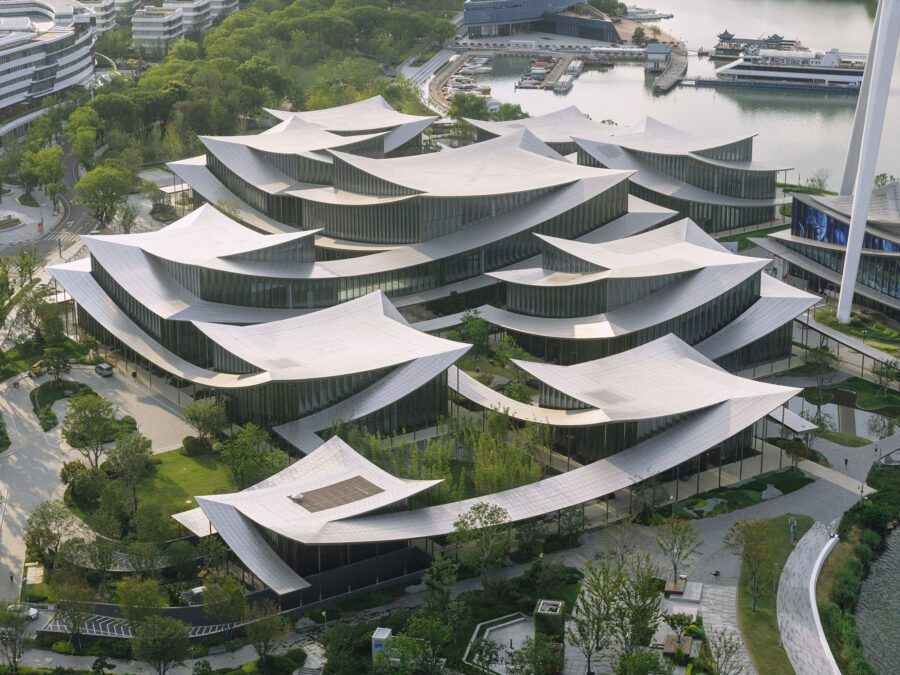![[大阪・関西万博 Report]OMA / 重松象平氏インタビュー ルイ・ヴィトン](https://magazine-asset.tecture.jp/wpcms/wp-content/uploads/2025/10/10164112/IMG_2634-2-1-900x675.jpeg)
CULTURE


© DDF_dos_KIT

© DDF_dos_KIT
〈テラティンバー(TerraTimber)〉は、コンピュテーショナルデザインやARを活用することで廃木材と土を再利用した建築です。廃材と自然素材を活用しつつ、解体を前提とした多層階構造のデモンストレーションとして建てられました。
デジタル技術を用いて廃木材を活用する「デジタル・アップサイクル」プロセスを採用した、建築におけるサーキュラーエコノミーの可能性を示す、ドイツのカールスルーエ工科大学(KIT)のDDF(Professorship for Digital Design and Fabrication)とdos(Professur Design of Structures)によるプロジェクトです。
(以下、DDFから提供されたプレスキットのテキストの抄訳)

© DDF_dos_KIT

© DDF_dos_KIT
廃木材と土を使ったデジタルコンストラクション
〈テラティンバー〉は、廃木材をデジタル技術を用いてアップサイクルし、再生材料を構造要素に持続可能な形で転換できる循環型建築システムを構築する革新的な手法を導入している。
このアプローチでは、多種多様な規格外の廃木材の複雑な管理に、コンピュータツールと拡張現実(AR)の製作プロセスを活用している。

© DDF_dos_KIT

© DDF_dos_KIT
画像処理によるデジタル在庫の作成から始まり、木材はコンピュータ上で大型構造要素に組み立てられ、最終的にARの支援を受けながら木製の釘で物理的に組み立てられる。
さらにハイブリッド・マテリアル・システムとして土を統合することで、天然素材とリサイクル可能な素材から持続可能な床スラブを構築することを可能にする。

© DDF_dos_KIT
廃材を活用した解体可能な多層階構造への未来を示すプロジェクト
この構造全体は「解体のための設計(Design for Disassembly)」の原則に基づいて設計された多階建て建築の1部分を例示しており、主要な柱と梁の枠組みには、金属を使用しない継手システムを採用している。
〈テラティンバー〉は、建築物の解体や産業廃棄物から発生する廃棄物の再利用が、産業の慣行をどのように変革し、廃棄物を建設における貴重な資源と捉えることで、直線的な経済モデルから循環型の経済モデルへと転換できるかを示している。

© DDF_dos_KIT

© DDF_dos_KIT
木と土のハイブリッド構造システム
このデモンストレーションの中心となるのは、木材と土のハイブリッド素材を使用した床スラブシステムである。このコンセプトでは、不規則な形の残材をユニークな配置で使用し、粗い表面をつくり出す。この表面に土を充填することで、金属を使用しない構造用せん断界面が2つの素材の間に形成される。
土は、環境に優しくリサイクル可能なコンクリート代替品として見なすことができ、ハイブリッド建材の耐荷重能力を高めるだけでなく、熱容量を構成要素にもたらし、優れた防音・防火効果を実現する。

© DDF_dos_KIT

© DDF_dos_KIT
コンピュテーショナルデザインとARを活用した廃木材の「デジタル・アップサイクル」
デジタル技術とコンピュテーショナルデザインは、廃棄物に見られる複雑性や多様性をナビゲートする能力により、循環型建築への移行において重要なツールとして台頭している。
この研究では、廃木材の複雑性に対処するために特別に調整されたアプローチを提示し、材料のデジタル化、廃木材の断片を集めるための反復計算、構造設計、デジタルモデルから物理的な製造への転送を含む共同開発されたワークフローを提示している。
この「デジタル・アップサイクル」アプローチでは、デジタル手法を駆使して小規模な廃棄物を大型の建築部材に再利用するというボトムアップ型の設計戦略が採用されている。

© DDF_dos_KIT

© DDF_dos_KIT

© DDF_dos_KIT

© DDF_dos_KIT

© DDF_dos_KIT

© DDF_dos_KIT

© DDF_dos_KIT

© DDF_dos_KIT

© DDF_dos_KIT

© DDF_dos_KIT

© DDF_dos_KIT
以下、DDFのリリース(英文)です。
TerraTimberDigital Construction Methods Reusing Waste Wood and EarthTerraTimber introduces an innovative method for the digital upcycling of waste wood to create circular construction systems enabling the sustainable transformation of reclaimed materials into structural elements.This approach utilizes computational tools and Augmented Reality (AR) fabrication processes to manage the complexity of diverse, non-standard waste wood materials. Starting from the generation of digital inventories through image processing, the wood pieces are then computationally assembled into large structural elements, which are finally physically assembled with nails made of wood and with the aid of AR. Earth is integrated to form a hybrid material system, enabling the construction of sustainable floor slabs from natural and recyclable materials.The overall structure exemplifies a fragment of a multi-story building designed with Design for Disassembly principles, employing an interlocking, metal-free joinery system for the primary post-and-beam framework.TerraTimber demonstrates how repurposing waste from building demolitions and industrial residues can transform industrial practices, shifting from a linear to a circular economic model by viewing waste as a valuable resource in construction.Wood-earth Hybrid Construction SystemThe core of the demonstrator is a floor slab system made from a wood-earth hybrid. This concept utilizes the unique arrangement of irregular leftover wood pieces to create a rough surface that, when filled with earth, forms a metal-free structural shear interface between the two materials. Earth can be seen as an ecological and recyclable concrete substitute that increases the load-bearing capacity of the hybrid building material, but also brings thermal mass into the component and ensures good sound and fire protection.Digital Upcycling: Leveraging Computational Design and Augmented Reality to Upcycle Waste WoodDigital techniques and computational design emerge as crucial tools in the transition towards circular construction thanks to their ability to navigate the complexity and variability found in waste materials. This research presents a specifically tailored approach to tackle the complexities of waste wood, delineating a co-developed workflow that includes material digitization, iterative computational design for aggregating the waste wood pieces, structural design, and the transfer from digital models to physical fabrication.This “Digital Upcycling” approach, where digital methods are at the forefront to repurpose small scale waste materials into large construction elements, embodies a bottom-up design strategy where the available resources guide the creation process.Project credits:Karlsruhe Institute of Technology (KIT)
Professorship for Digital Design and Fabrication (DDF): Tenure-Track Prof. Moritz Dörstelmann, Daniel Fischer, Vincent Witt, Erik Zanetti.
Professur Design of Structures (dos): Prof. Dr.-Ing. Professor Riccardo La Magna, Tamara Haußer.The project was built together with students from the Faculty of Architecture at KIT: Jeremy Brachat, Tobias Dillmann, Alexander Geiser, Maximilian Gilbert, Tim Hahnemann, Annika Heesen, Niklas Carl Maximilian Hetzel, Moritz Karkossa, Yelda Kayihan, Emil Kasimir Leyens, Ian Lülfing, Oskar Philipp Müller, Domagoj Radic, Julia Rauch, Paula Schmidt, Fynn Schmidt-Rohr, Jonas Schückle, Rebecca Steinbach, Elissa Sukar, Sebastian Vix, Niklas Walter, Monika Weiß, Niklas Wittig.Picture credits: @DDF_dos_KITWebsite and social media:Professorship Digital Design and Fabrication
Website: https://www.ddf-kit.de/
Instagram: @ddf.kit https://www.instagram.com/ddf.kit/
LinkedIn: https://www.linkedin.com/company/ddf-kitDesign of Structures
Website: https://dos.ieb.kit.edu/english/
Instagram: @dos.kit https://www.instagram.com/dos.kit/
LinkedIn: https://www.linkedin.com/company/dos-designofstructures/Keywords:
Digital Circular Construction, Wood Earth Hybrid, Waste Materials, Waste Wood, Computational Design, Digital Fabrication, Upcycling, Digital Upcycling, Circular Construction, Sustainable Construction
「TerraTimber」DDF 公式サイト
https://www.ddf-kit.de/terra-timber









